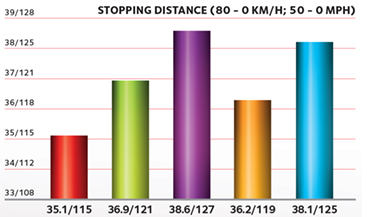feet AHEAD OF THE COMPETITION
In recent tests conducted on a Ford C-MAX at the MIRA proving ground, Ferodo once again proved its mettle. The tests were carried out according to Regulation R90 requirements – at a speed of 100 mph (160 km/h), and at 50 mph (80 km/h). In both tests, Ferodo significantly beat the stopping distance of major aftermarket competitors.
At high speeds, or highway driving, brake performance plays a major role in both vehicle and driver safety. Stopping in time allows you to avoid dangerous road accidents, and the distance required to bring the vehicle to a complete halt can make the difference between life and death. At 100 mph (160 km/h) the best-performing competitor stopped 13 feet (4 meters) further away than the Ferodo-equipped car. Four meters doesn’t sound like a long way, but in fact it’s the full length of the average sedan on the road today. It can mean complete avoidance of a serious road accident. And compare Ferodo to the worst competitor tested – we stop you over 70 feet (21 meters) quicker!
In urban driving, with the stop-start traffic everyone confronts on a daily basis, the ability to stop quickly and effectively from slower speeds is just as important as at high speeds. At 50 mph (80 km/h), Ferodo stops ahead of the competition again. Between 6.5 - 13 feet (2 to 4 meters) is the difference achieved when using Ferodo brake pads as opposed to competitor brakes. For the ultimate in safety, brake performance and stopping power, choose Ferodo OE-quality brake pads. For the ultimate in safety, brake performance and stopping power, choose Ferodo OE-quality brake pads.

Test Parameters
- This test was carried out according to Regulation R90 homologation procedures by Federal-Mogul engineers at the MIRA proving ground independent test facility in the U.K.
- Performed as part of the homologation requirements for a replacement brake pad, Regulation R90.
- Vehicle is braked from 80% of the maximum speed of the vehicle (in this case 100 mph [160 km/h] for Ford C-MAX).
- Vehicle is in a fully laden condition, at Gross Vehicle Weight (GVW).
- The stops are carried out using front and rear brakes, with the engine in gear.
- The axle which is not being tested (in this case the rear) is fitted with OES pads and rotors, in the fully bedded condition.